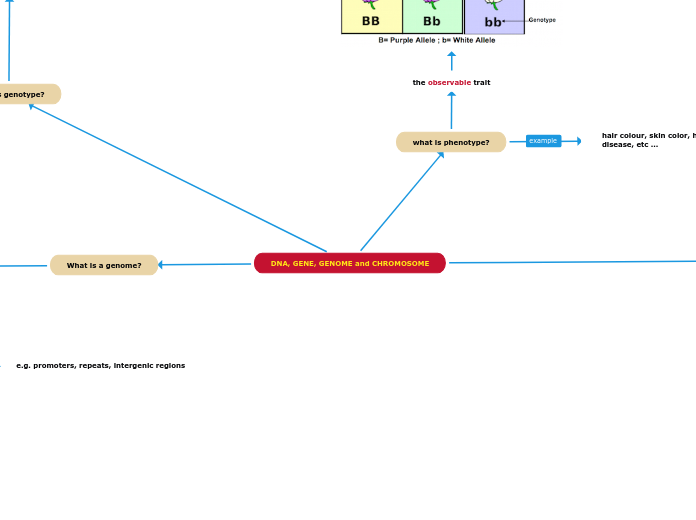DNA, GENE, GENOME and CHROMOSOME
what is genotype?
genetic makeup that determine the phenotype of an individual organism
Homozygous recessive (e.g. bb)
Heterozygous (e.g. Bb)
Homozygous dominant (e.g. BB)
determined by
allele
what is allele?
type
dominant
recessive
different forms of a gene
what is phenotype?
hair colour, skin color, height, glucose level, disease, etc ...
the observable trait
chromosome
structure
centromere
subtelomere
telomere
in human, chromosome is packaged in chromatin
what is chromatin?
a complex consisting of double helix DNA packed with protein histone (nucleosome)
23 paired chromosomes (human)
from 24 chromosomes
human is a diploid organism
what is diploid ?
haploid
only one copy of a chromosome
two copies of a chromosome inherited from each parent
chr17 from mother & father
humans have two versions of a gene e.g. P53
sex chromosome
labelled as chromosome chrX and chrY
Female = Two chrX
Male = chrX + chrY
autosome
chr1 until chr22
What is a genome?
the complete set of genetic material (DNA) in a cell
What is genetic material (DNA)?
can be divided into two, based on location
non-coding region
What is RNA?
can be classed into
non-coding RNA (ncRNA)
does not encode protein
Ribosomal RNA (rRNA) - http://www.bio.miami.edu/dana/250/250SS16_8print.html
merge with other proteins and tRNA to form the ribosome complex
in eukaryotes, a ribosome consist of two subunits
large subunit & small subunit
function of a ribosome is to catalyze the assembly of amino acids into polypeptide chains (i.e. protein)
Transfer RNA (tRNA)
function is to transfer the amino acids from cytoplasm to the ribosome
Antisense RNA
Small interfering RNA (siRNA)
double stranded
coding RNA
encode protein
e.g. Messenger RNA (mRNA)
similar to DNA but
Uracil (U) instead of Thymine (T)
so it has 4 nitrogen bases
Uracil (U)
mostly single-stranded
constitute 97-98%
increasing interest to study this region - very hard
the region that does not involve in encoding protein
classification
non-coding outside gene region
e.g. promoters, repeats, intergenic regions
non-coding inside gene region
e.g. introns
coding region
e.g. BRCA1 gene, TP53 gene, TNF gene
constitute only 2-3%
most studied part of the human genome
the region that code for protein
example of common DNA
Chloroplast DNA
Mitochondrial DNA
Nuclear DNA
DNA = Deoxyribonucleic acid
double-stranded helix
consist of chemical blocks called nucleotides
What is nucleotide?
“bases” vs “nucleotides”
refer to the 4 nitrogenous bases
approximately 3.2 billion base pairs (human)
refers to the entire chemical block, which includes the nitrogen base
4 common nitrogen bases for DNA
Cytosine (C)
Thymine (T)
Guanine (G)
Adenine (A)
consists of a sugar molecule attached to a phosphate group and a nitrogen base
genetic information that gets passed from one generation to the next









